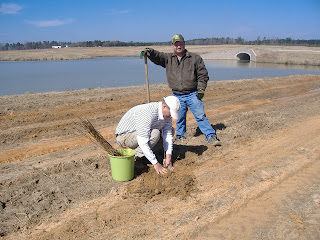Example of a weed not treated with a root inhibitor preemerge
Look closely and you can see the clubbed roots,
This particular preemerge was barricade(prodiamine)

Another example of clubbed roots
At Squire Creek we apply two application of Preemergence herbicides a year. Preemergence herbicides are applied to the turfgrass site prior to weed-seed germination and form a barrier at, or right below, the soil surface. Most preemergence herbicides prevent cell division during the weed seed germination as the emerging seedling comes into contact with the herbicide. Weeds that already have emerged at the time of application are not controlled consistently by preemergence herbicides because their primary growing points escape treatment. With this in mind you all can see how important the timing of the application has to be.
Preemerge herbicides are broken into 3 categories:
Preemerge herbicides are broken into 3 categories:
- Root Inhibitor-These herbicides inhibit the steps in plant cell division responsible for chromosome separation and cell wall formation. Roots are relatively few in number and club shaped. They bind to soil colloids and are unlikely to leach. These root inhibitors do not translocate. (ex. prodiamine, oryzaline,pendimethalin)
- Shoot Inhibitor- These herbicides can be applied to seedling grasses, some broadleaves and suppression of some perennials from tubers and rhizomes. This group is a very volatile and can be used in preplant situations. (ex. oxadiazon)
- Shoot and Root Inhibitors-These herbicides effect the shoots and the roots. (ex. dithiopy)


















.JPG)



